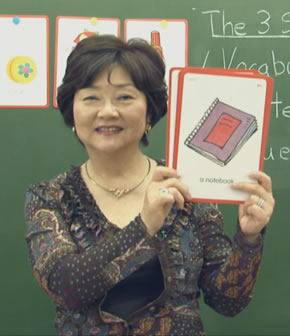
When I first started teaching, I couldn’t understand why my students could not always speak and use the language they had been taught. Sometimes they couldn’t even remember what they had learned in the previous lesson. They were excellent at repeating after me (like parrots), but they could not say anything on their own without lots of hints. They learned vocabulary, but sentences and question forms were difficult for them. I used to blame the students for not remembering – but it wasn’t their fault. It was mine.
I taught the only way I knew how and used the only texts available then, all of which were ESL focused. These texts included a lot of idioms and expressions, which were too difficult for my students, and there was not enough systematic language build-up to help them progress step by step. Later, I began to experiment with other teaching methods. I found that if I was systematic in my approach, but also varied the presentation and practice of target language, my students learned far more quickly – and actually had fun. I also had fun!
This discovery led to my Model, Action, Talk (MAT) Method. This method focuses on introducing new language in a way that links it with actions so that students remember more and USE the language with confidence (not just repeat it).
It’s important to remember that our students usually don’t hear or speak English on a daily basis. Therefore, we must give them the opportunity to practice as much as possible during class time. In Japan, our lessons run once a week, and usually last 50 to 60 minutes. That adds up to about 35 to 40 hours a year, which is not even two days! No wonder it is difficult to get our children to remember everything. So I devised a way to run intensive lessons that get students to have fun drilling and speaking. I use ‘six-second’ drill games, which are short, fast and fun. They keep the students’ attention and, because students are repeating new language many times at a NATURAL speaking speed, with corresponding actions, they remember it well.
After my students learn the new language, I give them more speaking practice through group activities and pairwork. Notice that I, the teacher, don’t call on individual students. Instead, while students are practicing as a class, in groups and in pairs, I can watch them to pick up problems. I then do more six-second drills for words and phrases that the students have found difficult. Then we do reinforcement activities (or what I call Learning Activities). These are fun games with specific goals that help students become confident in speaking alone with their friends.
Introducing new language to students can be challenging. It was for me when I first started teaching! So when I submitted my first drafts for Let’s Go, I included the most important thing that children need to learn a language: a systematic approach that starts with vocabulary, moves on to a sentence using the words in context, and then introduces question forms. Through these three steps, students can, and do, start talking to each other in their very first lessons.
The ‘Three Steps’:
- Vocabulary
- Sentence pattern
- Question form
Most teachers feel that teaching new vocabulary is the easiest step, followed closely by the sentence pattern. What they find most challenging seems to be teaching the question form. Some teachers have told me that they teach the vocabulary only – but I feel very strongly that our students need to know how to make sentences and ask questions by themselves to become independent speakers of English. With my ‘Three Steps’ technique, I find that children have the most fun practicing the question forms. They are thrilled to be able to speak in English to their friends.
In addition to the ‘Three Steps’, I have tried many ways to get students to learn and remember. Breaking away from the traditional teacher-centered way of teaching and making the whole lesson game-like, with the students doing most of the talking, has produced amazing results. I’ve also found that this approach takes the different learning styles of children into account which means that all my students are cared for and helped to learn. Using speed, rhythm, actions and speech simultaneously helps to stimulate both sides of the brain for maximum results. My students get excited about learning English and they especially enjoy talking to their friends in English.
I’d love to share some of the tips and techniques I’ve learned over my 30 years of teaching. Please join me for my webinar on Saturday, 26 January, where I will demonstrate how all three steps can be done quickly and easily, and how teaching the question form can be effective and fun. I will also focus on how to get students to use the articles, a & an properly. Then we’ll look at getting children to talk to each other!
In the meantime, here’s video clip showing how I make a shapes lesson memorable and fun. I’ll share more with you on 26 January!
Did you miss the webinar? You can watch the recording here. Visit Let’s Share for more videos, blogs and upcoming events by our Let’s Go authors.